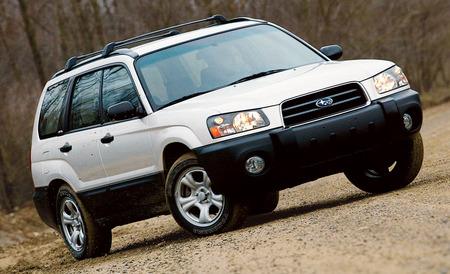The Forester is a truck. Never mind the carlike unibody or seat height, an arbitrary decision had to be made, and the Forester is our line in the sand: Anything this tall is a truck, anything shorter is a car. Enough said.
The new Forester that arrived in showrooms in May will continue to be our truck yardstick, even though it’s a hair-0.2 inch-shorter than the 2002 Forester. Every other exterior dimensional change is hardly worth mentioning. The 99.4-inch wheelbase is the same as the 2002’s, length is down by 0.4 inch, and width by 0.2.
In Ann Arbor, Foresters have nearly approached mosquito status-they’re all over the place. Although our local dealer looks like a fair representation of the lawn shops that first sold Subarus alongside grass cutters, it moves more Foresters than any other dealer in Michigan, about 170 a year. “It’s our bread-and-butter car,” says Pete van Buren, the sales manager at Ann Arbor Subaru.
Van Buren is looking forward to the new car, but he’s quick to add, “Even five years after the Forester was introduced, they don’t hang around the lot for long.” The Forester has averaged 50,000 sales per year since it arrived in 1997. Last year, Subaru set a record for itself when it sold 185,944 vehicles, of which almost 30 percent-or 55,041 cars-were Foresters, the oldest design in Subaru’s fleet.
So who could blame Subaru for only carefully tinkering with the Forester formula when designing the new car? Not only are the dimensions nearly identical, but the outside still has the familiar carved-from-a-brick shape. It’s a bit more rounded now, the fender flares are more graceful, there’s a new grille, and the rear tailgate has a horizontal black strip that separates the glass from the sheetmetal, and it does a good job of lessening the slab motif. Subaru says the new body has a drag coefficient of 0.35 for both models, the base 2.5X and the 2.5XS. The 2002 base car had a 0.39 coefficient of drag. In an effort to reduce weight, the hood, the bumper beams, and the roof rails are now aluminum. In a town where people can be slow to recognize the Z06 badge that denotes the fastest of Corvettes, the new Forester did not go unnoticed.
The interior was also completely redone. The tachometer and speedo get their own bezels, and a third one houses the fuel and temperature gauges. A strip of dimpled, soft-touch plastic runs across the dash and onto the doors. The trim that surrounds the climate controls and the radio now has a metallic finish. The new front seats can be raised an additional 1.5 inches and have 0.7-inch-more legroom. The rears retain the 60/40 folding split, but now there’s a center armrest, and Subaru says the seat bottom has been resculpted to increase comfort.
Although the car’s a hair smaller, it’s bigger inside. Upfront, passenger volume rises one cubic foot from 53 to 54, and the rear is three cubic feet larger, going from 39 to 42. Behind the rear seats, there’s 32 cubic feet of space, and with the rear seats folded there’s 64, five more than the 2002 model’s 59 cubic feet. Order the optional glass sunroof, and rear space drops to 30 and 63 cubic feet.
Mechanically, there’s less to report. The 2.5-liter flat-four remains and has the same power (165 horsepower at 5600 rpm) and torque (166 pound-feet at 4000 rpm) as it did for 2002. A five-speed manual is standard, and the four-speed automatic is optional. The five-speed’s first two gear ratios are a smidge shorter to account for the slightly larger standard 16-inch tires and to preserve off-the-line grunt. The rest of the ratios and the final drive remain unchanged.
All Foresters come standard with a full-time four-wheel-drive system. Unlike some other utes that primarily drive the front wheels and only call in the rears when the fronts slip, Subarus drive all four wheels all the time. Five-speed Foresters have a center differential that relies on a viscous limited-slip feature to apportion power between the front and rear axles. Automatics rely on an electronically controlled clutch pack to handle that duty. Since both of these systems are always engaged, there’s no need to flip any switches for maximum traction.


Leave a Reply